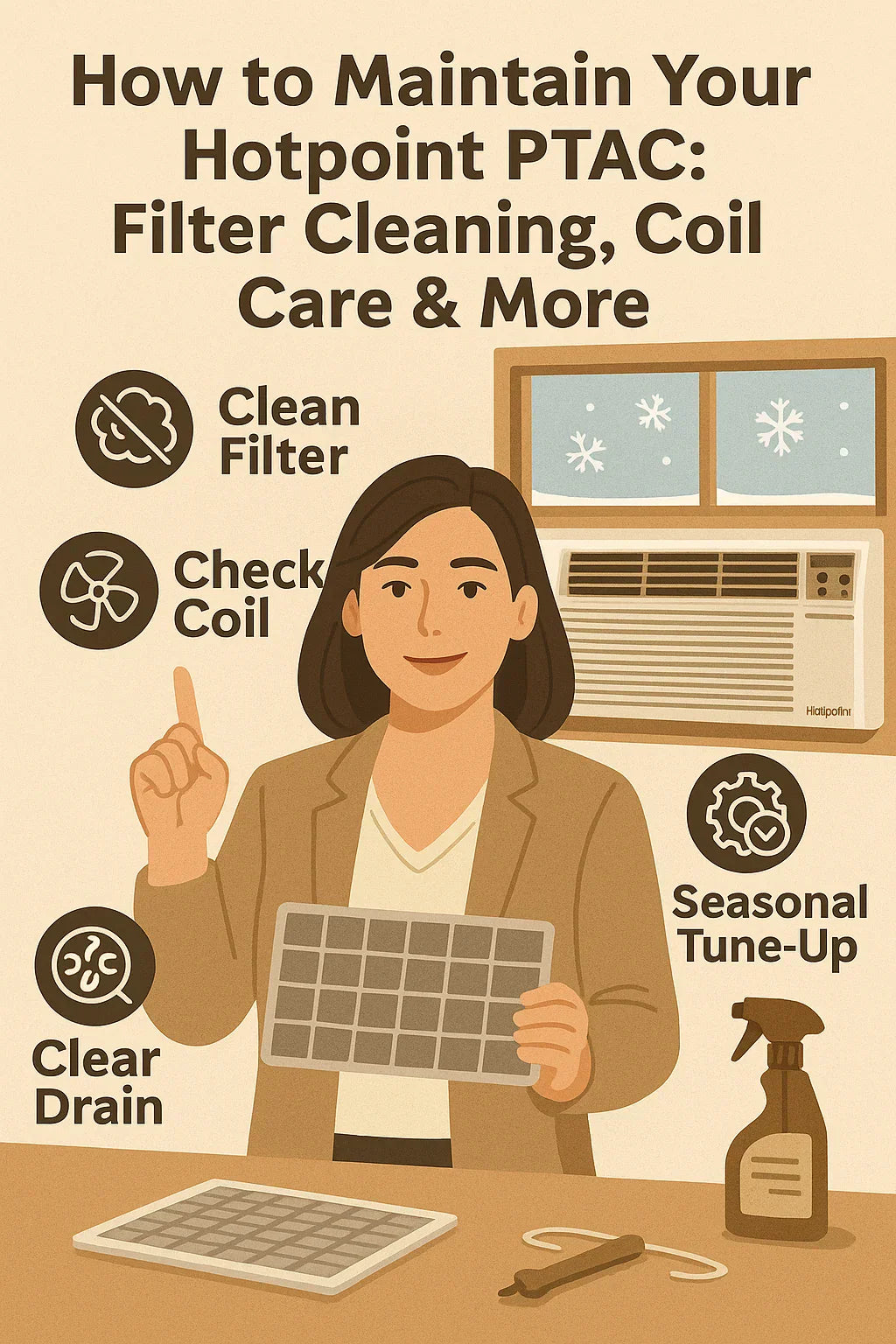A well-maintained PTAC (Packaged Terminal Air Conditioner) unit can last more than a decade—but only if you take care of it. Whether you're a homeowner, rental manager, or just someone who values efficiency like Savvy, routine maintenance is essential to keep your Hotpoint AHHS07D3XXA running at peak performance.
In this comprehensive guide, we’ll walk through everything you need to know about maintaining your Hotpoint PTAC, from monthly filter cleaning to seasonal coil checks.
🛠️ Why PTAC Maintenance Is Worth It
Skipping maintenance might seem harmless, but over time, it can cause real problems:
Benefits of Regular PTAC Care:
-
Up to 15% improvement in energy efficiency
-
Prevents airflow blockages and overheating
-
Reduces dust, mold, and odors
-
Extends lifespan (average PTAC life = 10+ years with upkeep)
-
Saves on repair costs and downtime
According to Energy Star, neglecting regular cleaning can reduce efficiency and air quality.
🛋 Monthly Task: Clean the Air Filter
Your Hotpoint PTAC includes a reusable mesh air filter behind the front panel. Dirty filters are the #1 cause of poor performance.
How to Clean It:
-
Turn off the unit and unplug it (if plug-in).
-
Open or remove the front panel.
-
Slide out the air filter.
-
Rinse under warm water. Use mild soap if needed.
-
Let it air dry completely before reinserting.
Pro Tips:
-
Never use bleach or harsh cleaners
-
Replace if torn or permanently discolored
-
Clean every 30 days, or more often if you have pets or live in a dusty area
Savvy keeps a calendar reminder on her phone to clean her filter on the first of every month.
❄️ Quarterly Task: Clean the Evaporator Coil
The evaporator coil is located just behind the filter and cools the air during A/C operation.
Why It Matters:
-
Dust buildup = poor cooling + icing on coils
-
Can cause the system to short cycle or overwork
Steps:
-
Turn off power and remove front cover
-
Gently brush or vacuum the coil fins
-
Use compressed air or no-rinse coil cleaner spray
-
Avoid bending the fins
🔥 Check the Condenser Coil (Back of the Unit)
Located on the rear (outside) of the PTAC, this coil releases heat during cooling and absorbs it in heating mode (heat pump).
Seasonal Tasks:
-
Remove the rear grille to access coil
-
Gently vacuum or spray with garden hose
-
Clear leaves, spider webs, and debris
-
Ensure at least 12 inches of clearance from plants, walls, or fences
Do this in spring and fall to prepare for cooling/heating seasons.
💧 Drain Pan and Condensate Line
PTACs create condensate (water) while running. If the drain system is clogged or misaligned, water can back up or leak into your space.
How to Check:
-
Tilt the unit slightly downward toward outside (built-in with most sleeves)
-
Check the drain pan under the evaporator coil
-
Clear algae or mold buildup with disinfectant or vinegar
-
Confirm that water flows freely through drain line
Optional:
-
Use a condensate pump if draining is uphill or to a distant location
⚖️ Biannual System Check: Savvy’s Checklist
Every 6 months, go beyond just filter cleaning and check all major functions.
Bonus:
- Use a ceiling fan in reverse mode (clockwise) in winter to circulate warm air from your PTAC
🪨 Warning Signs That Maintenance Is Overdue
-
Musty or burning smell
-
Weak airflow even on high fan
-
Unit frequently turns on/off (short cycling)
-
Temperature doesn’t match thermostat
-
Water pooling inside or beneath unit
These signs may point to a dirty filter, clogged coil, or failing backup heat kit—all of which regular maintenance can prevent.
🛬 When to Call a Pro
While most maintenance can be DIY, call an HVAC professional for:
-
Deep internal coil cleanings
-
Refrigerant pressure checks
-
Diagnosing capacitor or compressor issues
-
Strange noises or smells that persist after cleaning
Expect to pay $100–$150 for a full PTAC tune-up.
Tip: Book service in late spring or early fall before the busy HVAC season.
🔧 Recommended Tools & Products
| Item | Use Case |
|---|---|
| Soft brush / microfiber | Coil and vent cleaning |
| Coil cleaner (non-acidic) | Evaporator/condenser coils |
| Fin comb | Straighten bent coil fins |
| Compressed air | Blow out dust and debris |
| Caulk / foam sealant | Weatherproof sleeve edges |
Also keep extra filters and a backup power cord if you travel or manage rentals.
👍 Savvy’s PTAC Care Routine
Savvy keeps her AHHS07D3XXA in tip-top shape with a consistent, light-touch maintenance routine:
Her Personal Schedule:
-
Cleans filter monthly
-
Wipes the grille and front panel weekly with natural cleaner
-
Uses a ceiling fan to assist air distribution
-
Cleans both coils twice a year
-
Runs test cycles at the start of summer and winter
Her unit is now 3 years old, runs quietly, and maintains temperature reliably even during Texas heat waves and chilly fronts.
📄 Helpful Resources
✅ Final Takeaway
Maintaining your Hotpoint PTAC isn’t complicated—but it does require consistency. Monthly filter cleaning, seasonal coil checks, and annual inspections can help your system run better, last longer, and cost less.
Just like Savvy, you can keep your PTAC whisper-quiet and worry-free with a few minutes of care each month.
In the next topic we will know more about: Is a PTAC Right for Your Airbnb or Rental Unit? Guest Comfort & Control







